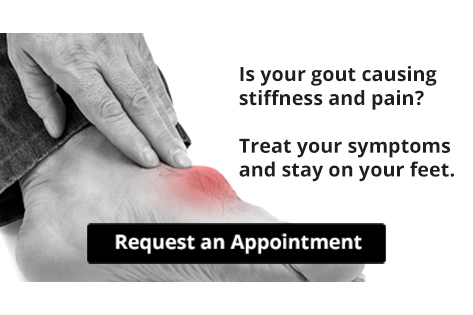Super User
Rheumatoid Arthritis May Affect the Feet
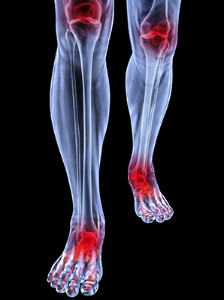 The medical condition that is known as rheumatoid arthritis is recognized as one of the most inflammatory types of arthritis. The majority of patients who have this ailment may experience uncomfortable foot conditions. Some common symptoms that are associated with this form of arthritis can include swollen joints, limited mobility, and the foot may change shape. There can also be friction in a portion of the foot that is a result of swelling and inflammation. This may cause sacs that are filled with fluid to develop which are known as bursa. These sacs may form on the bottom of the foot, in addition to the heel pad and surrounding area. If your feet are in pain and sore, it is suggested that you schedule a consultation with a podiatrist who can properly diagnose rheumatoid arthritis.
The medical condition that is known as rheumatoid arthritis is recognized as one of the most inflammatory types of arthritis. The majority of patients who have this ailment may experience uncomfortable foot conditions. Some common symptoms that are associated with this form of arthritis can include swollen joints, limited mobility, and the foot may change shape. There can also be friction in a portion of the foot that is a result of swelling and inflammation. This may cause sacs that are filled with fluid to develop which are known as bursa. These sacs may form on the bottom of the foot, in addition to the heel pad and surrounding area. If your feet are in pain and sore, it is suggested that you schedule a consultation with a podiatrist who can properly diagnose rheumatoid arthritis.
Because RA affects more than just your joints, including the joints in your feet and ankles, it is important to seek early diagnosis from your podiatrist if you feel like the pain in your feet might be caused by RA. For more information, contact one of our podiatrists of Westside Podiatry Center, LLP. Our doctors will assist you with all of your podiatric concerns.
What Is Rheumatoid Arthritis?
Rheumatoid Arthritis (RA) is an autoimmune disorder in which the body’s own immune system attacks the membranes surrounding the joints. Inflammation of the lining and eventually the destruction of the joint’s cartilage and bone occur, causing severe pain and immobility.
Rheumatoid Arthritis of the Feet
Although RA usually attacks multiple bones and joints throughout the entire body, almost 90 percent of cases result in pain in the foot or ankle area.
Symptoms
- Swelling and pain in the feet
- Stiffness in the feet
- Pain on the ball or sole of feet
- Joint shift and deformation
Diagnosis
Quick diagnosis of RA in the feet is important so that the podiatrist can treat the area effectively. Your doctor will ask you about your medical history, occupation, and lifestyle to determine the origin of the condition. Rheumatoid Factor tests help to determine if someone is affected by the disease.
If you have any questions please feel free to contact one of our offices located in Liverpool, Camillus, Skaneateles, Oswego, and Cicero, NY . We offer the newest diagnostic and treatment technologies for all your foot and ankle needs.
Read more about Rheumatoid Arthritis in the FeetRheumatoid Arthritis in the Feet
Although rheumatoid arthritis attacks multiple bones and joints throughout the entire body, ninety percent of people who actually develop this condition usually do so in the foot or ankle area. Those who develop this kind of arthritis in the feet usually develop symptoms around the toes and forefeet first, before anywhere else. Rheumatoid arthritis appears to have a genetic component. If it runs in the family, then you will be more likely to develop it as well.
Rheumatoid arthritis is an autoimmune disorder in which the body’s own immune system attacks the lining of the membranes surrounding the joints. This causes inflammation of the membrane lining, and the gradual destruction of the joint’s cartilage and even bone.
Some of the most common symptoms that are associated with RA include pain and swelling of the feet. Stiffness in the feet is also another common symptom that people experience. Those who have RA in the feet usually feel the pain in the ball or sole of their feet. This can get to be very painful at times. A person's joints can even shift and become deformed after a period of time.
In order to properly diagnose RA in the feet it is usually necessary for a doctor or podiatrist to evaluate the area. Your doctor will also question you about your medical history, occupation, etc., to determine whether anything in your lifestyle may have triggered the condition. There are a number of tests that may be performed to help diagnose RA, such as a rheumatoid factor test. There is, however, no one single test that will tell you for sure if you have RA. There are different X-rays that can be taken as well to determine if a person has RA in their feet.
There is a range of treatment options for rheumatoid arthritis. Treatment of RA is usually a lifelong process that includes a variety of methods of treatment and therapy. Your doctor can prescribe special shoes that should help with arch support as well as heel support. A physical therapist can help those with this condition learn exercises which will keep their joints flexible. Surgery may be needed to correct some of the issues with the feet, such as bunions, and hammertoes. Fusion is usually the most successful surgical option for rheumatoid arthritis. However, people need to keep in mind that there are some risks associated with these surgeries.
Possible Uses of PRP Injections
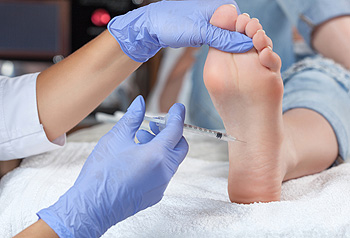 Platelet-rich plasma therapy, which is also known as PRP injections, is generally used to accelerate the healing process for several conditions. Additionally, it may help to reduce inflammation in tendons, ligaments, and muscles that may be a result of a severe injury. After a small sample of blood is taken from the patient, it is spun in a centrifuge. This machine is effective in separating the platelets from other portions of the blood. At this point, it is injected into the affected area, and the healing process begins. If you have a foot condition that you believe may benefit from the use of PRP injections, it is advised that you consult with a podiatrist who can determine the best course of treatment for you.
Platelet-rich plasma therapy, which is also known as PRP injections, is generally used to accelerate the healing process for several conditions. Additionally, it may help to reduce inflammation in tendons, ligaments, and muscles that may be a result of a severe injury. After a small sample of blood is taken from the patient, it is spun in a centrifuge. This machine is effective in separating the platelets from other portions of the blood. At this point, it is injected into the affected area, and the healing process begins. If you have a foot condition that you believe may benefit from the use of PRP injections, it is advised that you consult with a podiatrist who can determine the best course of treatment for you.
If you are suffering from a foot condition, contact one of our podiatrists of Westside Podiatry Center, LLP. Our doctors will assist you with all of your podiatric concerns.
What Is PRP?
Platelet Rich Plasma, or PRP, is blood taken from a patient and spun in a centrifuge, concentrating the amount of platelets. The plasma is then re-injected into the site of injury or damage, assisting the body in repairing damage to muscles, tendons, ligaments, and tissue. PRP helps the body speed up its healing process.
Uses of PRP
Injuries affecting the foot sometimes don’t heal properly because of poor blood circulation. The healing time slows down, and recovery time is affected by poor blood supply. PRP injections will speed up recovery and resolve this issue.
Treatment
PRP is the first regenerative treatment for damaged muscles, tendons, and ligaments. No surgery needed. It is only applied with an insertion of a needle.
Ultrasound – An ultrasound is needed for proper placement of the platelets.
Injection – When the first injection is received, the patient will return to the doctor in about 2 to 3 weeks and monitor the recovery process.
Recovery time – Some people respond to treatments differently. Therefore, depending on your condition, the doctor will make any remaining decisions on how many more injections are needed, or if any additional ones are even required.
Benefits
One may be able to avoid major surgery, and recovery time will be cut down. PRP injections also avoid creating scar tissue and damage to the area. Risks are also very low using PRP as a treatment. There is no risk of rejection, contracting a disease from using another person’s blood, or infection.
If you have any questions please feel free to contact one of our offices located in Liverpool, Camillus, Skaneateles, Oswego, and Cicero, NY . We offer the newest diagnostic and treatment technologies for all your foot and ankle needs.
Read more about PRP Injections in the FeetPRP Injections in the Feet
Platelets are cells in the blood that help form clots to stop bleeding. PRP (Platelet-rich plasma) utilizes an individual’s own concentrated platelets, which has many growth factors. These growth factors are used to heal injuries and relieve symptoms. At times, PRP may eliminate the need for other medications or surgery. Many famous athletes such as Tiger Woods and Rafael Nadal have used PRP injections and experienced success.
PRP can be created in approximately 25-30 minutes. The process starts with drawing a small amount of blood from the patient, and then placing it into a centrifuge. A centrifuge is a machine that spins the blood at a high speed to separate the red blood cells from the concentrated platelets. The concentrated platelet rich plasma is the PRP that is used in the treatment process.
This regenerative treatment can treat many different types of ailments. Chronic tendon injuries, acute ligament and muscle injuries, and fractures may be treated with PRP. PRP works by being injected into the injured area. If someone has Achilles tendonitis, the PRP will be mixed with an anesthetic and this combination can be injected directly into the inflamed tissue. The pain may be more severe after the first week or two, and it may take several weeks for the patient to experience improvement.
In some cases, PRP may be used along with surgery to improve healing. For example, if someone with a torn heel cord requires surgery, the healing process may be expedited by treating the injured area with PRP during surgery. However, this must be done in a specific way in which the PRP is stitched into the torn tissues.
Prior to using PRP injections, you should weigh the pros and cons to decide whether this treatment is right for you. Some of the benefits are that areas of the body that have limited blood supply, such as the feet, will receive a boost in oxygen and nutrients. Another benefit is that the injections will prevent further tissue degeneration. However, there are many drawbacks to using PRP. One of the cons is that it may take several weeks for you to feel its beneficial effects. Another downside is that many insurance companies do not cover the treatment because it is experimental. The approximate cost of PRP may range from $250-$800 depending on how many injections are necessary.
How Cracked Heels Develop and How to Treat Them
 Cracked heels are generally a common condition among those who typically wear open footwear. Besides having a displeasing appearance, cracked heels can also be very uncomfortable and painful for patients who are afflicted with this ailment. Common causes that lead to the development of cracked heels may include standing for the majority of the day, increased pressure on the heels due to obesity, and certain skin conditions such as eczema or athlete’s foot. Along with the pain they may cause, cracked heels that are more severe can also lead to bleeding. It is said one way to help begin the process of healing cracked heels is by drinking plenty of water and remaining hydrated. Applying moisturizers, petroleum jelly, healing cream, and moisturizing socks may also help to reduce the dryness in your heels. Patients have also found soaking their feet, followed by using a pumice stone as an exfoliant, is helpful in treating cracked heels. For more advice on how to best treat cracked heels, please consult with a podiatrist for treatment plans and professional care.
Cracked heels are generally a common condition among those who typically wear open footwear. Besides having a displeasing appearance, cracked heels can also be very uncomfortable and painful for patients who are afflicted with this ailment. Common causes that lead to the development of cracked heels may include standing for the majority of the day, increased pressure on the heels due to obesity, and certain skin conditions such as eczema or athlete’s foot. Along with the pain they may cause, cracked heels that are more severe can also lead to bleeding. It is said one way to help begin the process of healing cracked heels is by drinking plenty of water and remaining hydrated. Applying moisturizers, petroleum jelly, healing cream, and moisturizing socks may also help to reduce the dryness in your heels. Patients have also found soaking their feet, followed by using a pumice stone as an exfoliant, is helpful in treating cracked heels. For more advice on how to best treat cracked heels, please consult with a podiatrist for treatment plans and professional care.
Cracked heels are unsightly and can cause further damage to your shoes and feet. If you have any concerns, contact one of our podiatrists from Westside Podiatry Center, LLP. Our doctors can provide the care you need to keep you pain-free and on your feet.
Cracked Heels
Cracked heels appear unappealing and can make it harder for you walk around in sandals. Aside from looking unpleasant, cracked heels can also tear stockings, socks, and wear out your shoes. There are several methods to help restore a cracked heel and prevent further damage.
How Do You Get Them?
Dry skin is the number one culprit in creating cracked heels. Many athletes, walkers, joggers, and even swimmers suffer from cracked heels. Age and skin oil production play a role to getting cracked heels as well.
Promote Healing
Over the counter medicines can help, especially for those that need instant relief or who suffer from chronic dry feet.
Wear Socks – Wearing socks with medicated creams helps lock in moisture.
Moisturizers – Applying both day and night will help alleviate dryness which causes cracking.
Pumice Stones – These exfoliate and remove dead skin, which allows for smoother moisturizer application and better absorption into the skin.
Change in Diet
Eating healthy with a well-balanced diet will give the skin a fresh and radiant look. Your body responds to the kinds of food you ingest. Omega-3 fatty acids and zinc supplements can also revitalize skin tissue.
Most importantly, seek professional help if unsure how to proceed in treating cracked heels. A podiatrist will help you with any questions or information needed.
If you have any questions, please feel free to contact one of our offices located in Liverpool, Camillus, Skaneateles, Oswego, and Cicero, NY . We offer the newest diagnostic and treatment technologies for all your foot care needs.
Read more about Solutions for Cracked HeelsSolutions for Cracked Heels
Cracked heels can make life very frustrating and embarrassing when displaying the bare feet. Aside from being unpleasing to the eye, they can also tear stockings and socks and wear out shoes at a faster rate. When severe, cracked heels may cause pain or infection.
Cracked heels are a problem for those who are athletic, those who may walk a lot, and those who have especially dry skin. Those who use medication that dry the skin, those who swim often, wearing certain types of shoes, and those who are diabetic may have trouble with cracked heels. Seniors whose skin produces less oil may also have trouble with cracked feet. There is no one way to develop cracked feet, and there is no cure.
Today, the market consists of numerous products that have a variety of ingredients to promote healing. Some of these are over-the-counter. Others are prescribed by a doctor, especially for those who have chronic dry feet and heels.
Some doctors recommend wearing socks at night for those with rough skin. This helps further healing, and helps creams stay on longer and better absorb into the skin.
One way to alleviate dryness that causes cracked heels is by using moisturizers both day and night. Another way is to make sure the skin is clean and dry at all times. Using a pumice stone to buff away dead skin before putting on moisturizer can also help. Cracked heels will not respond to the cream unless the outer layer of skin is first removed through exfoliation. After exfoliation, lotion or ointment will be absorbed by the skin more easily.
Foods that produce healing and balance can also help the skin from within. Everything that is put into the body can either help it or hurt it. Taking supplements of omega-3 fatty acids and zinc can also be very beneficial.
Nevertheless, not all products are guaranteed to help treat cracked feet. Seeing a professional is best if other treatments options were unsuccessful. A podiatrist should be able to give the best advice to help with this problem.
Alleviate the Pain of Your Corns
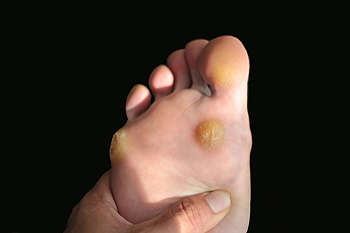 Corns, typically found on the toes, side, and bottom of the feet, can be incredibly uncomfortable and often painful. Simple everyday activities, such as walking, can become difficult if corns are left untreated. Corns are hardened layers of the skin, often caused by too much friction and the use of improper footwear. They can feel very sensitive when touched, and often become irritated when shoes are worn. To help lessen the pain of a corn, it’s advised that you wear a cushion or pad over your corn to stop any further friction. It is also suggested to soak the feet in warm water, and filing at the corn may help to decrease its size. In order to safely treat your corn, it is recommended to consult with a podiatrist for professional care.
Corns, typically found on the toes, side, and bottom of the feet, can be incredibly uncomfortable and often painful. Simple everyday activities, such as walking, can become difficult if corns are left untreated. Corns are hardened layers of the skin, often caused by too much friction and the use of improper footwear. They can feel very sensitive when touched, and often become irritated when shoes are worn. To help lessen the pain of a corn, it’s advised that you wear a cushion or pad over your corn to stop any further friction. It is also suggested to soak the feet in warm water, and filing at the corn may help to decrease its size. In order to safely treat your corn, it is recommended to consult with a podiatrist for professional care.
Corns can make walking very painful and should be treated immediately. If you have questions regarding your feet and ankles, contact one of our podiatrists of Westside Podiatry Center, LLP. Our doctors will treat your foot and ankle needs.
Corns: What Are They? And How Do You Get Rid of Them?
Corns are thickened areas on the skin that can become painful. They are caused by excessive pressure and friction on the skin. Corns press into the deeper layers of the skin and are usually round in shape.
Ways to Prevent Corns
There are many ways to get rid of painful corns such as:
- Wearing properly fitting shoes that have been measured by a professional
- Wearing shoes that are not sharply pointed or have high heels
- Wearing only shoes that offer support
Treating Corns
Although most corns slowly disappear when the friction or pressure stops, this isn’t always the case. Consult with your podiatrist to determine the best treatment option for your case of corns.
If you have any questions please feel free to contact one of our offices located in Liverpool, Camillus, Skaneateles, Oswego, and Cicero, NY . We offer the newest diagnostic and treatment technologies for all your foot and ankle needs.
Read more about Corns and CallusesCorns and Calluses
A corn is a lesion that forms in the skin of the foot, and it is typically circular in shape, small in size, and thick and rough in texture. A corn generally occurs as a result of repeated pressure on the skin; one example of this is the rubbing of a shoe against the skin. Corns differ from calluses in that their central cores are harder in texture.
A corn is a relatively common condition with a wide variety of treatment options. If a corn becomes overly uncomfortable or painful, consult with your podiatrist; he can determine the best method of treatment that is appropriate for you. Corns may return if the underlying cause of its development is not treated or removed. Avoid removing corns at home, as improper removal may cause infection.
A callus, similar to a corn, is an area of skin that has become thickened due to repeated pressure and rubbing. The rubbing causes the skin to create a layer of protective skin, which is the formed callus. Calluses can differ in size between people, and they can also become painful.
Multiple treatments are available for calluses. At-home treatment and removal should be avoided, as this can potentially lead to infection. Your podiatrist can best determine the cause of your calluses and suggest the treatment most appropriate for you.
What Is Neuropathy?
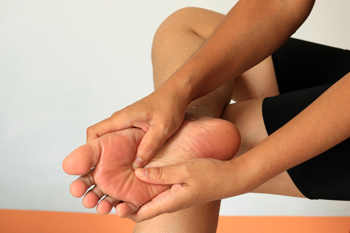 The central nervous system is connected by the peripheral nerves to the nerves in the body. These nerves deliver physical sensations to the brain. The medical condition that is referred to as peripheral neuropathy can occur if the nerves become damaged or destroyed. This may happen as a result of genetic traits, an injury, or if there is an existing infection. Some of the symptoms that are associated with this disorder can consist of a tingling sensation in the hands and feet, excessive sweating, and the feet may feel heavy. A proper diagnosis is generally performed by a podiatrist, which can help to determine the extent of the ailment. This can often include having a blood test, CT scan, or MRI taken. If you are experiencing any of these symptoms, it is strongly suggested that you consult with a podiatrist who can help you to manage this condition.
The central nervous system is connected by the peripheral nerves to the nerves in the body. These nerves deliver physical sensations to the brain. The medical condition that is referred to as peripheral neuropathy can occur if the nerves become damaged or destroyed. This may happen as a result of genetic traits, an injury, or if there is an existing infection. Some of the symptoms that are associated with this disorder can consist of a tingling sensation in the hands and feet, excessive sweating, and the feet may feel heavy. A proper diagnosis is generally performed by a podiatrist, which can help to determine the extent of the ailment. This can often include having a blood test, CT scan, or MRI taken. If you are experiencing any of these symptoms, it is strongly suggested that you consult with a podiatrist who can help you to manage this condition.
Neuropathy
Neuropathy can be a potentially serious condition, especially if it is left undiagnosed. If you have any concerns that you may be experiencing nerve loss in your feet, consult with one of our podiatrists from Westside Podiatry Center, LLP. Our doctors will assess your condition and provide you with quality foot and ankle treatment for neuropathy.
What Is Neuropathy?
Neuropathy is a condition that leads to damage to the nerves in the body. Peripheral neuropathy, or neuropathy that affects your peripheral nervous system, usually occurs in the feet. Neuropathy can be triggered by a number of different causes. Such causes include diabetes, infections, cancers, disorders, and toxic substances.
Symptoms of Neuropathy Include:
- Numbness
- Sensation loss
- Prickling and tingling sensations
- Throbbing, freezing, burning pains
- Muscle weakness
Those with diabetes are at serious risk due to being unable to feel an ulcer on their feet. Diabetics usually also suffer from poor blood circulation. This can lead to the wound not healing, infections occurring, and the limb may have to be amputated.
Treatment
To treat neuropathy in the foot, podiatrists will first diagnose the cause of the neuropathy. Figuring out the underlying cause of the neuropathy will allow the podiatrist to prescribe the best treatment, whether it be caused by diabetes, toxic substance exposure, infection, etc. If the nerve has not died, then it’s possible that sensation may be able to return to the foot.
Pain medication may be issued for pain. Electrical nerve stimulation can be used to stimulate nerves. If the neuropathy is caused from pressure on the nerves, then surgery may be necessary.
If you have any questions, please feel free to contact one of our offices located in Liverpool, Camillus, Skaneateles, Oswego, and Cicero, NY . We offer the newest diagnostic and treatment technologies for all your foot care needs.
Read more about Neuropathy